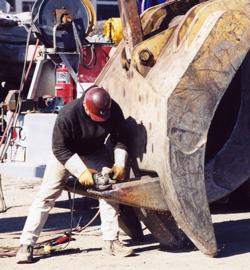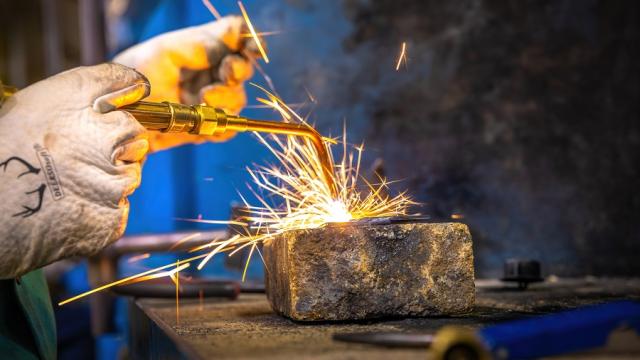Common Welding Repair Work Issues and Exactly How to Address Them Successfully
Welding fixings often experience a series of concerns that can jeopardize the honesty of the final product. Usual issues consist of inadequate penetration, porosity, and misalignment, to name a few. Each defect offers distinct challenges that require specific approaches for resolution. Understanding these concerns is vital for welders intending to enhance their skills and outcomes. This conversation will certainly discover these typical welding fixing issues and reliable techniques to address them.
Insufficient Infiltration
Insufficient infiltration takes place when the weld steel falls short to fully fuse with the base product, leading to weak joints and prospective architectural failings. This concern commonly stems from not enough warm input, incorrect electrode angle, or incorrect welding speed. Welders might run into poor penetration because of a miscalculation of the essential specifications for a specific product thickness or type. In addition, contamination on the base material's surface can impede effective bonding, worsening the issue. To deal with insufficient infiltration, welders ought to guarantee suitable settings on their equipment and preserve a clean job surface. Normal examination of welds is suggested to identify any kind of shortages early, enabling timely corrections and the prevention of endangered structural integrity in welded assemblies.
Porosity
Porosity is a common problem in bonded joints that materializes as small gas bubbles caught within the weld metal. This issue can compromise the stability of the weld, resulting in lowered toughness and prospective failure under stress. Belgrade Fabrication. Porosity usually develops from contamination, wetness, or improper welding techniques, which permit gases to escape into the liquified weld pool. To deal with porosity, welders must guarantee correct surface area prep work, preserve a tidy functioning setting, and make use of appropriate welding criteria. Furthermore, selecting the right filler material and shielding gas can reduce gas entrapment. Routine evaluation and screening of welds can aid identify porosity early, ensuring prompt rehabilitative activities are taken, thereby preserving the high quality and reliability of the welded framework
Misalignment
Misalignment in welding can develop from various factors, including inappropriate arrangement and thermal growth. Recognizing the origin is vital for efficient resolution. Numerous improvement methods are readily available to straighten elements and guarantee structural integrity.
Reasons for Imbalance
Welding imbalance commonly stems from a selection of underlying concerns that can endanger architectural honesty. One main cause is inappropriate fit-up of parts before welding, which can cause spaces and uneven surface areas. Variants in thermal expansion throughout the welding procedure can also result in distortion, particularly if the materials being joined have various coefficients of expansion. Additionally, inadequate clamping and fixturing may fail to hold components firmly in position, bring about activity during welding. Poorly maintained equipment, including welding devices and devices, might introduce incongruities in the weld bead, more adding to misalignment. Lastly, driver mistake, coming from inadequate training or experience, can also play a significant role in creating misaligned welds.
Modification Methods Available
Dealing with misalignment successfully calls for a combination of rehabilitative techniques customized to the particular problems at hand. One common approach is the use of components or jigs to hold elements in the proper position during welding, making certain consistent placement. In addition, preheating the products can help lower distortion and boost fit-up. For significant imbalance, mechanical adjustment strategies, such as utilizing hydraulic jacks or clamps, can be utilized to fix the setting before welding. Post-weld heat therapy might also be essential to relieve stress and anxieties triggered by imbalance. Lastly, careful examination and change during the configuration phase can stop imbalance concerns from ending up being considerable troubles, promoting a smoother welding procedure and improving general structural integrity.
Distortion
Distortion is a typical obstacle in welding that can emerge from numerous factors, including uneven cooling and heating. Understanding the causes of distortion is necessary for executing effective prevention techniques. Resolving this concern not just boosts architectural honesty yet likewise improves the overall top quality of the weld.
Reasons of Distortion
When based on the intense warmth of welding, materials usually undergo modifications that can bring about distortion. This sensation largely occurs from thermal growth and tightening during the welding process. As the weld area heats up, the material expands; upon cooling, it gets, which can create inner stress and anxieties. Additionally, irregular heating throughout a work surface can intensify these tensions, leading to bending or flexing. The kind of material also plays a substantial duty; metals with varying thermal conductivity and coefficients of expansion might react in different ways, resulting in uncertain distortions. Bad joint style and inadequate fixturing can contribute to imbalance during welding, boosting the probability of distortion. Recognizing these reasons is essential for efficient welding repair and prevention strategies.
Avoidance Techniques
Effective prevention techniques for distortion during welding concentrate on controlling warm go to this website input and guaranteeing proper joint style. Maintaining a regular warm input aids to reduce thermal growth and tightening, which can lead to distortion. Making use of methods such as preheating the work surface can additionally lower the temperature level slope, promoting consistent home heating. In addition, selecting appropriate joint styles, such as T-joints or lap joints, can improve stability and reduce tension focus. Implementing correct fixturing to safeguard the workpieces in area even more aids in keeping placement during the welding process. Ultimately, staggered welding sequences can disperse warmth extra equally, protecting against local distortion. By applying these techniques, welders can substantially lower the possibility of distortion and boost the general quality of their welds.
Fracturing
Splitting is a common issue encountered in welding repair services, often resulting from different variables such as improper air conditioning rates, material selection, or inadequate joint preparation. The occurrence of cracks can considerably endanger the honesty of the weld, leading to potential failings during operation. To address this concern, welders should initially analyze the source, making certain that products are suitable and suitably chosen for the specific application. In addition, managing the cooling rate throughout the welding process is essential; quick air conditioning can generate stress and bring about breaking. Proper joint layout and prep work also add to decreasing the threat. Carrying out these approaches can improve weld high quality and resilience, eventually minimizing the likelihood of splitting in finished weldments.

Insufficient Combination
A substantial problem in welding fixings is insufficient fusion, which takes place when the weld metal does not adequately bond with the base product or previous weld passes - Montana Mobile Welding and Repair Belgrade. This defect can cause weaknesses in the joint, potentially compromising the honesty of the welded framework. Factors contributing to incomplete combination include not enough warm resource input, improper welding strategy, and contamination of the surface areas being signed up with. To resolve this concern properly, welders must ensure correct pre-weld cleansing and surface area preparation, along with adjust their welding specifications to attain sufficient penetration and combination. Routine inspection during the welding process can also help recognize incomplete fusion early, enabling for timely corrective steps to boost the general high quality of the weld
Overheating
While welding repairs can enhance architectural honesty, overheating provides a substantial challenge that can bring about product deterioration. Too much heat throughout welding can change the mechanical residential properties of steels, resulting in minimized stamina, boosted brittleness, and warping. This phenomenon is specifically important in high-stress applications where structural dependability is paramount. Recognizing overheating can entail aesthetic examinations for discoloration or distortion, along with checking temperature level during the welding procedure. To mitigate the risks connected with getting too hot, welders need to utilize proper techniques, such as regulating heat input, adjusting traveling rate, and making use of suitable filler materials. In addition, executing pre- and post-weld warmth therapies can assist recover product properties and boost the general top quality of the repair service, guaranteeing long-term efficiency and security.
Frequently Asked Questions
What Are the Common Signs of a Welding Flaw?

Just How Can I Test My Welds for Quality?
To evaluate welds for quality, one can utilize visual evaluations, ultrasonic screening, and radiographic approaches. Each technique assures architectural honesty, determines problems, and confirms adherence to defined requirements, eventually improving the reliability of the bonded joints.
What Security Preventative Measures Should I Take While Welding?
When welding, one must prioritize safety by wearing proper personal protective equipment, guaranteeing appropriate air flow, protecting flammable products away, maintaining a tidy work space, and recognizing environments to avoid accidents and injuries.
Can I Repair a Weld Without Renovating the Entire Joint?
Fixing a weld without redoing the entire joint is possible, depending upon the damages (Montana Mobile Welding and Repair Belgrade Fabrication). Techniques such as grinding, including filler product, or utilizing a welding procedure can effectively resolve certain problems while maintaining the bordering structure
What Equipment Are Necessary for Reliable Welding Repairs?
Necessary tools for effective welding repair work include a welding maker, wire brush, mill, safety gear, clamps, and filler materials. Each tool plays a crucial role in making sure high quality and safety and security throughout the fixing process. Porosity normally emerges from contamination, dampness, or improper welding strategies, which enable gases to run away into the liquified weld pool. Inadequately conserved tools, including welding equipments and tools, may introduce inconsistencies in the weld grain, additional adding to misalignment. When subjected to the extreme heat of welding, products frequently go through changes that can lead to distortion. Breaking is a typical issue encountered in welding repairs, typically resulting from various aspects such as incorrect air conditioning prices, product option, or poor joint preparation. A substantial problem Get More Info in welding fixings is incomplete combination, which takes place when the weld metal does not effectively bond with the base product or previous weld passes.